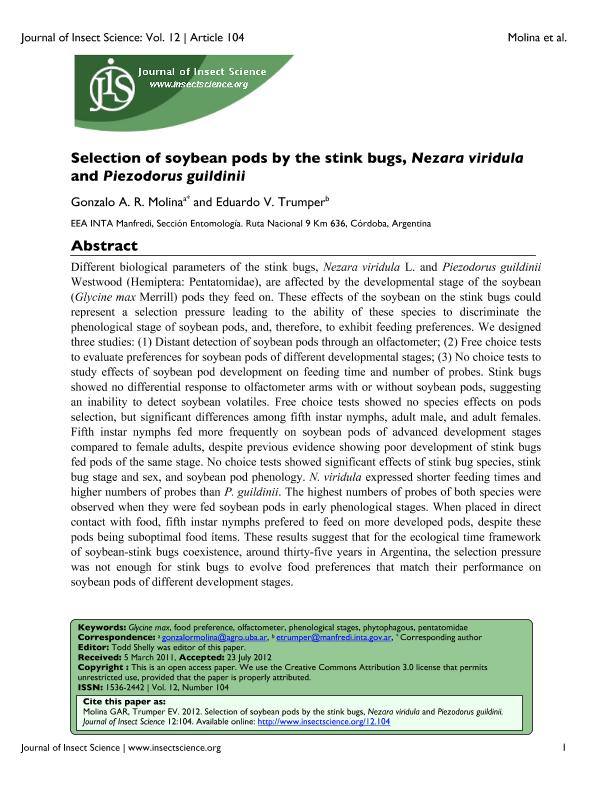Mostrar el registro sencillo del ítem
dc.contributor.author
Molina, Gonzalo Alberto Roman

dc.contributor.author
Trumper, Eduardo

dc.date.available
2018-09-19T19:33:52Z
dc.date.issued
2012-08
dc.identifier.citation
Molina, Gonzalo Alberto Roman; Trumper, Eduardo; Selection of soybean pods by the stink bugs, Nezara viridula and Piezodorus guildinii; University of Arizona; Journal of Insect Science; 12; 8-2012; 1-16
dc.identifier.issn
1536-2442
dc.identifier.uri
http://hdl.handle.net/11336/60303
dc.description.abstract
Different biological parameters of the stink bugs, Nezara viridula L. and Piezodorus guildinii Westwood (Hemiptera: Pentatomidae), are affected by the developmental stage of the soybean (Glycine max Merrill) pods they feed on. These effects of the soybean on the stink bugs could represent a selection pressure leading to the ability of these species to discriminate the phenological stage of soybean pods, and, therefore, to exhibit feeding preferences. We designed three studies: (1) Distant detection of soybean pods through an olfactometer; (2) Free choice tests to evaluate preferences for soybean pods of different developmental stages; (3) No choice tests to study effects of soybean pod development on feeding time and number of probes. Stink bugs showed no differential response to olfactometer arms with or without soybean pods, suggesting an inability to detect soybean volatiles. Free choice tests showed no species effects on pods selection, but significant differences among fifth instar nymphs, adult male, and adult females. Fifth instar nymphs fed more frequently on soybean pods of advanced development stages compared to female adults, despite previous evidence showing poor development of stink bugs fed pods of the same stage. No choice tests showed significant effects of stink bug species, stink bug stage and sex, and soybean pod phenology. N. viridula expressed shorter feeding times and higher numbers of probes than P. guildinii. The highest numbers of probes of both species were observed when they were fed soybean pods in early phenological stages. When placed in direct contact with food, fifth instar nymphs prefered to feed on more developed pods, despite these pods being suboptimal food items. These results suggest that for the ecological time framework of soybean-stink bugs coexistence, around thirty-five years in Argentina, the selection pressure was not enough for stink bugs to evolve food preferences that match their performance on soybean pods of different development stages.
dc.format
application/pdf
dc.language.iso
eng
dc.publisher
University of Arizona

dc.rights
info:eu-repo/semantics/openAccess
dc.rights.uri
https://creativecommons.org/licenses/by-nc-sa/2.5/ar/
dc.subject
Food Preference
dc.subject
Glycine Max
dc.subject
Olfactometer
dc.subject
Pentatomidae
dc.subject
Phenological Stages
dc.subject
Phytophagous
dc.subject.classification
Otras Ciencias Biológicas

dc.subject.classification
Ciencias Biológicas

dc.subject.classification
CIENCIAS NATURALES Y EXACTAS

dc.title
Selection of soybean pods by the stink bugs, Nezara viridula and Piezodorus guildinii
dc.type
info:eu-repo/semantics/article
dc.type
info:ar-repo/semantics/artículo
dc.type
info:eu-repo/semantics/publishedVersion
dc.date.updated
2018-09-10T16:30:52Z
dc.journal.volume
12
dc.journal.pagination
1-16
dc.journal.pais
Estados Unidos

dc.journal.ciudad
Arizona
dc.description.fil
Fil: Molina, Gonzalo Alberto Roman. Consejo Nacional de Investigaciones Científicas y Técnicas; Argentina. Instituto Nacional de Tecnología Agropecuaria. Centro Regional Córdoba. Estación Experimental Agropecuaria Manfredi; Argentina
dc.description.fil
Fil: Trumper, Eduardo. Consejo Nacional de Investigaciones Científicas y Técnicas; Argentina. Instituto Nacional de Tecnología Agropecuaria. Centro Regional Córdoba. Estación Experimental Agropecuaria Manfredi; Argentina
dc.journal.title
Journal of Insect Science

dc.relation.alternativeid
info:eu-repo/semantics/altIdentifier/doi/https://dx.doi.org/10.1673/031.012.10401
dc.relation.alternativeid
info:eu-repo/semantics/altIdentifier/url/https://academic.oup.com/jinsectscience/article/12/1/104/888361
Archivos asociados
